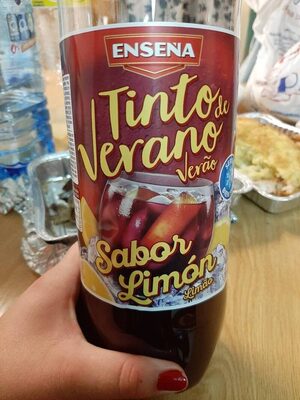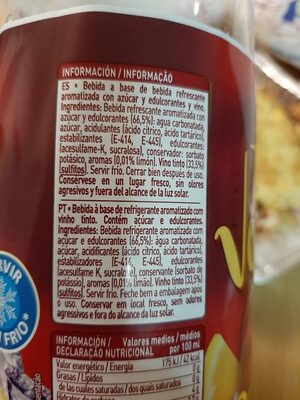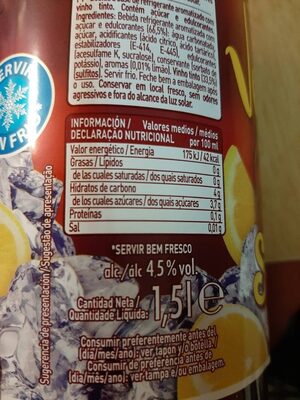Help us make food transparency the norm!
As a non-profit organization, we depend on your donations to continue informing consumers around the world about what they eat.
The food revolution starts with you!
Tinto de verano Ensena - 1.5 Litros
Tinto de verano Ensena - 1.5 Litros
This product page is not complete. You can help to complete it by editing it and adding more data from the photos we have, or by taking more photos using the app for Android or iPhone/iPad. Thank you!
×
Barra-kodea: 8480024175533 (EAN / EAN-13)
Kopurua: 1.5 Litros
Markak: Ensena
Kategoriak: en:Beverages, en:Alcoholic beverages, en:Wines, en:Red wines, en:Wine-based drinks
Saltzen diren herrialdeak: Espainia
Matching with your preferences
Health
-
Reduce or stop drinking alcohol
Less is better
This might not be the answer people want to hear, but there is no safe level for drinking alcohol. Of course there is lower-risk drinking, but WHO does not set particular limits, because the evidence shows that the ideal situation for health is to not drink at all. Alcohol is closely related to around 60 different diagnoses and for almost all there is a close dose–response relationship, so the more you drink, the higher your risk of disease. Less is better.
Source: World Health Organization (WHO) - Q&A – How can I drink alcohol safely?
Osagaiak
-
18 ingredients
: Bebida refrescante aromatizada con azucar y edulcorantes (66,5%): agua carbonatada, azúcar, acidulantes (ácido cítrico, ácido tartárico), estabilizantes (E-414, E-445), edulcorantes: (acesulfame-K, sucralosa), conservador: sorbato potásico, aromas (0,01% limón). Vino tinto (33,5%) sulfitos.Alergenoak: en:Sulphur dioxide and sulphites
Food processing
-
Ultra processed foods
Elements that indicate the product is in the 4 - Ultra prozesatutako elikagaiak eta edariak group:
- Gehigarria: E414
- Gehigarria: E445
- Gehigarria: E950
- Gehigarria: E955
- Osagaia: Flavouring
- Osagaia: Sweetener
Food products are classified into 4 groups according to their degree of processing:
- Prozesatu gabeko edo ahalik eta gutxien prozesatutako elikagaiak
- Sukaldaritzako osagaiak prozesatu
- Prozesatutako jakiak
- Ultra processed foods
The determination of the group is based on the category of the product and on the ingredients it contains.
Gehigarriak
-
E202
Potassium sorbate: Potassium sorbate is the potassium salt of sorbic acid, chemical formula CH3CH=CH−CH=CH−CO2K. It is a white salt that is very soluble in water -58.2% at 20 °C-. It is primarily used as a food preservative -E number 202-. Potassium sorbate is effective in a variety of applications including food, wine, and personal-care products. While sorbic acid is naturally occurring in some berries, virtually all of the world's production of sorbic acid, from which potassium sorbate is derived, is manufactured synthetically.Source: Wikipedia (Ingeles)
-
E330 - Azido zitriko
Citric acid: Citric acid is a weak organic acid that has the chemical formula C6H8O7. It occurs naturally in citrus fruits. In biochemistry, it is an intermediate in the citric acid cycle, which occurs in the metabolism of all aerobic organisms. More than a million tons of citric acid are manufactured every year. It is used widely as an acidifier, as a flavoring and chelating agent.A citrate is a derivative of citric acid; that is, the salts, esters, and the polyatomic anion found in solution. An example of the former, a salt is trisodium citrate; an ester is triethyl citrate. When part of a salt, the formula of the citrate ion is written as C6H5O3−7 or C3H5O-COO-3−3.Source: Wikipedia (Ingeles)
-
E334 - Azido tartariko
Tartaric acid: Tartaric acid is a white, crystalline organic acid that occurs naturally in many fruits, most notably in grapes, but also in bananas, tamarinds, and citrus. Its salt, potassium bitartrate, commonly known as cream of tartar, develops naturally in the process of winemaking. It is commonly mixed with sodium bicarbonate and is sold as baking powder used as a leavening agent in food preparation. The acid itself is added to foods as an antioxidant and to impart its distinctive sour taste. Tartaric is an alpha-hydroxy-carboxylic acid, is diprotic and aldaric in acid characteristics, and is a dihydroxyl derivative of succinic acid.Source: Wikipedia (Ingeles)
-
E414
Gum arabic: Gum arabic, also known as acacia gum, arabic gum, gum acacia, acacia, Senegal gum and Indian gum, and by other names, is a natural gum consisting of the hardened sap of various species of the acacia tree. Originally, gum arabic was collected from Acacia nilotica which was called the "gum arabic tree"; in the present day, gum arabic is collected from acacia species, predominantly Acacia senegal and Vachellia -Acacia- seyal; the term "gum arabic" does not indicate a particular botanical source. In a few cases so‐called "gum arabic" may not even have been collected from Acacia species, but may originate from Combretum, Albizia or some other genus. Producers harvest the gum commercially from wild trees, mostly in Sudan -80%- and throughout the Sahel, from Senegal to Somalia—though it is historically cultivated in Arabia and West Asia. Gum arabic is a complex mixture of glycoproteins and polysaccharides. It is the original source of the sugars arabinose and ribose, both of which were first discovered and isolated from it, and are named after it. Gum arabic is soluble in water. It is edible, and used primarily in the food industry as a stabilizer, with EU E number E414. Gum arabic is a key ingredient in traditional lithography and is used in printing, paint production, glue, cosmetics and various industrial applications, including viscosity control in inks and in textile industries, though less expensive materials compete with it for many of these roles. While gum arabic is now produced throughout the African Sahel, it is still harvested and used in the Middle East.Source: Wikipedia (Ingeles)
-
E445
Glycerol ester of wood rosin: Glycerol ester of wood rosin, also known as glyceryl abietate or ester gum, is an oil-soluble food additive -E number E445-. The food-grade material is used in foods, beverages, and cosmetics to keep oils in suspension in water, and its name may be shortened in the ingredient list as glycerol ester of rosin. It is also used as an ingredient in the production of chewing-gum and ice cream. Similar, less pure materials -glycerol ester of gum rosin- are used as a component of certain low-cost adhesives.To make the glycerol ester of wood rosin, refined wood rosin is reacted with glycerin to produce the glycerol ester. Glycerol ester of wood rosin is an alternative to brominated vegetable oil in citrus oil-flavored soft drinks. In some cases, both ingredients are used together.Source: Wikipedia (Ingeles)
-
E950
Acesulfame potassium: Acesulfame potassium - AY-see-SUL-faym-, also known as acesulfame K -K is the symbol for potassium- or Ace K, is a calorie-free sugar substitute -artificial sweetener- often marketed under the trade names Sunett and Sweet One. In the European Union, it is known under the E number -additive code- E950. It was discovered accidentally in 1967 by German chemist Karl Clauss at Hoechst AG -now Nutrinova-. In chemical structure, acesulfame potassium is the potassium salt of 6-methyl-1‚2,3-oxathiazine-4-3H--one 2‚2-dioxide. It is a white crystalline powder with molecular formula C4H4KNO4S and a molecular weight of 201.24 g/mol.Source: Wikipedia (Ingeles)
-
E955
Sucralose: Sucralose is an artificial sweetener and sugar substitute. The majority of ingested sucralose is not broken down by the body, so it is noncaloric. In the European Union, it is also known under the E number E955. It is produced by chlorination of sucrose. Sucralose is about 320 to 1‚000 times sweeter than sucrose, three times as sweet as both aspartame and acesulfame potassium, and twice as sweet as sodium saccharin. Evidence of benefit is lacking for long-term weight loss with some data supporting weight gain and heart disease risks.It is stable under heat and over a broad range of pH conditions. Therefore, it can be used in baking or in products that require a long shelf life. The commercial success of sucralose-based products stems from its favorable comparison to other low-calorie sweeteners in terms of taste, stability, and safety. Common brand names of sucralose-based sweeteners are Splenda, Zerocal, Sukrana, SucraPlus, Candys, Cukren, and Nevella. Canderel Yellow also contains sucralose, but the original Canderel and Green Canderel do not.Source: Wikipedia (Ingeles)
Ingredients analysis
-
en:Palm oil free
No ingredients containing palm oil detected
Unrecognized ingredients: es:bebida-refrescante-aromatizada-con-azucar-y-edulcorantesSome ingredients could not be recognized.
We need your help!
You can help us recognize more ingredients and better analyze the list of ingredients for this product and others:
- Edit this product page to correct spelling mistakes in the ingredients list, and/or to remove ingredients in other languages and sentences that are not related to the ingredients.
- Add new entries, synonyms or translations to our multilingual lists of ingredients, ingredient processing methods, and labels.
If you would like to help, join the #ingredients channel on our Slack discussion space and/or learn about ingredients analysis on our wiki. Thank you!
-
en:Vegan status unknown
Unrecognized ingredients: es:bebida-refrescante-aromatizada-con-azucar-y-edulcorantes, en:SulfiteSome ingredients could not be recognized.
We need your help!
You can help us recognize more ingredients and better analyze the list of ingredients for this product and others:
- Edit this product page to correct spelling mistakes in the ingredients list, and/or to remove ingredients in other languages and sentences that are not related to the ingredients.
- Add new entries, synonyms or translations to our multilingual lists of ingredients, ingredient processing methods, and labels.
If you would like to help, join the #ingredients channel on our Slack discussion space and/or learn about ingredients analysis on our wiki. Thank you!
-
en:Vegetarian status unknown
Unrecognized ingredients: es:bebida-refrescante-aromatizada-con-azucar-y-edulcorantes, en:SulfiteSome ingredients could not be recognized.
We need your help!
You can help us recognize more ingredients and better analyze the list of ingredients for this product and others:
- Edit this product page to correct spelling mistakes in the ingredients list, and/or to remove ingredients in other languages and sentences that are not related to the ingredients.
- Add new entries, synonyms or translations to our multilingual lists of ingredients, ingredient processing methods, and labels.
If you would like to help, join the #ingredients channel on our Slack discussion space and/or learn about ingredients analysis on our wiki. Thank you!
-
Details of the analysis of the ingredients
We need your help!
Some ingredients could not be recognized.
We need your help!
You can help us recognize more ingredients and better analyze the list of ingredients for this product and others:
- Edit this product page to correct spelling mistakes in the ingredients list, and/or to remove ingredients in other languages and sentences that are not related to the ingredients.
- Add new entries, synonyms or translations to our multilingual lists of ingredients, ingredient processing methods, and labels.
If you would like to help, join the #ingredients channel on our Slack discussion space and/or learn about ingredients analysis on our wiki. Thank you!
: Bebida refrescante aromatizada con azucar y edulcorantes 66.5% (agua carbonatada), azúcar, acidulantes (ácido cítrico, ácido tartárico), estabilizantes (e414, e445), edulcorantes (acesulfame-K), sucralosa, conservador (sorbato potásico), aromas (limón 0.01%), Vino tinto 33.5%, sulfitos- Bebida refrescante aromatizada con azucar y edulcorantes -> es:bebida-refrescante-aromatizada-con-azucar-y-edulcorantes - percent: 66.5
- agua carbonatada -> en:carbonated-water - vegan: yes - vegetarian: yes - ciqual_food_code: 18066
- azúcar -> en:sugar - vegan: yes - vegetarian: yes - ciqual_proxy_food_code: 31016
- acidulantes -> en:acid
- ácido cítrico -> en:e330 - vegan: yes - vegetarian: yes
- ácido tartárico -> en:e334 - vegan: yes - vegetarian: yes
- estabilizantes -> en:stabiliser
- e414 -> en:e414 - vegan: yes - vegetarian: yes
- e445 -> en:e445 - vegan: yes - vegetarian: yes
- edulcorantes -> en:sweetener
- acesulfame-K -> en:e950 - vegan: yes - vegetarian: yes
- sucralosa -> en:e955 - vegan: yes - vegetarian: yes
- conservador -> en:preservative
- sorbato potásico -> en:e202 - vegan: yes - vegetarian: yes
- aromas -> en:flavouring - vegan: maybe - vegetarian: maybe
- limón -> en:lemon - vegan: yes - vegetarian: yes - ciqual_proxy_food_code: 13009 - percent: 0.01
- Vino tinto -> en:red-wine - vegan: maybe - vegetarian: yes - ciqual_food_code: 5214 - percent: 33.5
- sulfitos -> en:sulfite
Elikadura
-
Nutri-Score not-applicable
Not-applicable for the category: Alcoholic beverages
⚠ ️Nutri-Score not applicable for this product category.Could you add the information needed to compute the Nutri-Score?
-
Nutrition facts
Nutrition facts As sold
per servingCompared to: en:Wine-based drinks Energia 176 kj
(42 kcal)Koipe 0 g Gantz-azido ase 0 g Carbohydrates 4 g Azukre 3,7 g Fiber ? Proteina 1 g Gatz arrunt 1 g Fruits‚ vegetables‚ nuts and rapeseed‚ walnut and olive oils (estimate from ingredients list analysis) 0,01 %
Ingurumena
-
Eco-Score D - High environmental impact
The Eco-Score is an experimental score that summarizes the environmental impacts of food products.→ The Eco-Score was initially developped for France and it is being extended to other European countries. The Eco-Score formula is subject to change as it is regularly improved to make it more precise and better suited to each country.Life cycle analysis
-
Average impact of products of the same category: C (Score: 47/100)
Kategoria: Wine-based aperitif
Kategoria: Wine-based aperitif
- PEF environmental score: 0.16 (the lower the score, the lower the impact)
- including impact on climate change: 1.09 kg CO2 eq/kg of product
Stage Impact Agriculture
46.6 %Processing
9.3 %Ontziratzea
30.8 %Transportation
9.2 %Distribution
2.7 %Consumption
1.5 %
Bonuses and maluses
-
Missing origins of ingredients information
Malus: -5
⚠ ️ The origins of the ingredients of this product are not indicated.
If they are indicated on the packaging, you can modify the product sheet and add them.
If you are the manufacturer of this product, you can send us the information with our free platform for producers.
-
Missing packaging information for this product
Malus: -15
⚠ ️ The information about the packaging of this product is not filled in.⚠ ️ For a more precise calculation of the Eco-Score, you can modify the product page and add them.
If you are the manufacturer of this product, you can send us the information with our free platform for producers.
Eco-Score for this product
-
Impact for this product: D (Score: 27/100)
Produktua: Tinto de verano Ensena - 1.5 Litros
Life cycle analysis score: 47
Sum of bonuses and maluses: -20
Final score: 27/100
-
Carbon footprint
-
Equal to driving 0.6 km in a petrol car
109 g CO² per 100g of product
The carbon emission figure comes from ADEME's Agribalyse database, for the category: Wine-based aperitif (Source: ADEME Agribalyse Database)
Stage Impact Agriculture
27.6 %Processing
9.4 %Ontziratzea
43.8 %Transportation
17.2 %Distribution
1.4 %Consumption
0.6 %
Ontziratzea
-
Missing packaging information for this product
⚠ ️ The information about the packaging of this product is not filled in.Take a photo of the recycling information Take a photo of the recycling information
Transportation
-
Origins of ingredients
Missing origins of ingredients information
⚠ ️ The origins of the ingredients of this product are not indicated.
If they are indicated on the packaging, you can modify the product sheet and add them.
If you are the manufacturer of this product, you can send us the information with our free platform for producers.Add the origins of ingredients for this product Add the origins of ingredients for this product
Report a problem
-
Incomplete or incorrect information?
Category, labels, ingredients, allergens, nutritional information, photos etc.
If the information does not match the information on the packaging, please complete or correct it. Open Food Facts is a collaborative database, and every contribution is useful for all.
Datuen iturria
Product added on by elcoco
Last edit of product page on by srtepe.
Produktuaren orria -gatik editatua elcoco.cd6ca7ef33edf4a2754b588d0564f3c2, kiliweb, thaialagata, yuka.ZVo1WlNyNDVoOGdVdy9NYjdDdkwxL2QvOTZPRVFsaXJKclV6SVE9PQ.








